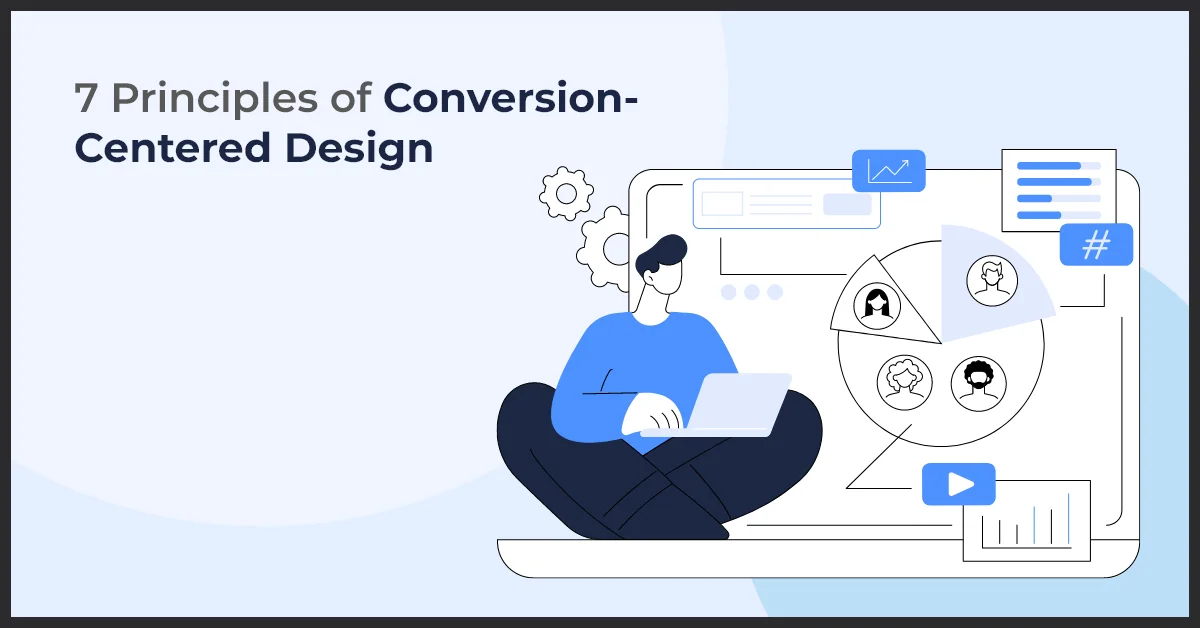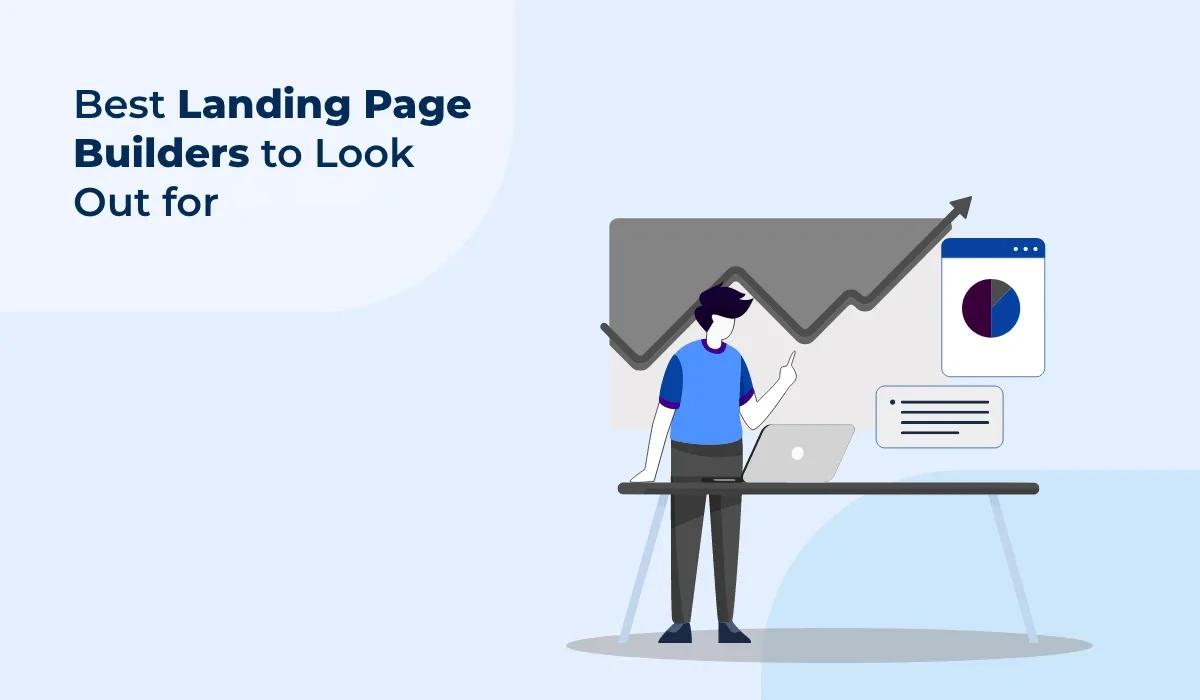Conversion-Centered Design: Boost Engagement & Maximize Conversions

Published on: November 26, 2021
Updated on: March 21, 2025
1814 Views
- Web Design
7 min read
Design is the make-or-break element for marketers.
Studies say that users only take 50 milliseconds (ms) to form an opinion about your web page’s visual appeal and 48% of users judge your business’s credibility by looking at your website design. That means, you only have a few milliseconds to showcase your brand and make an impact.
This is why it’s crucial for marketers to get the design right before running a campaign. But not everyone has the required expertise or experience to ensure it. You might be able to pinpoint that there is something wrong with the landing page design or the app UI, but it can be a challenge to zero in on the real problem.
A good designer can help you achieve your goals but when making the final design decision, you may still feel stuck. So how to overcome this problem?
The key to nailing this aspect of your job is to get the principles of good design on your fingertips. Good design is one of the major factors that help drive conversions for your business. Therefore, it is also often referred to as conversion-centered design (CCD).
Before we talk about the principles, let’s understand more about CCD.
What is Conversion-Centered Design?
CCD is a framework used for creating high-converting marketing campaigns. Whether it is your website, a flyer, or the app interface CCD incorporates all the key elements that make the design appealing to the eyes and encourage users to take desired actions on your page. It is a constantly evolving framework and has been changing with the change in design philosophy and user aspirations. At its core sit seven principles that shape all high-con verting marketing materials.
Seven Principles of Conversion-Centered Design
#1 Focus is Everything
Whether you are getting a landing page, app UI, or printed ad material designed, it is important to draw the user’s attention to the key area of the page. There are distinctive design elements including texts, logos, and graphics that go into ads, landing pages, and app UIs. However, it is important to ensure that the core element of the design encapsulates maximum attention.
The element that leads users to the desired action should be highlighted in the design. There are several ways to achieve this including bolder text, playing with size, colors and placing the element at parts of the landing page that grab maximum attention.
Let’s look at the image below of the app UI. What is the first word that comes to your mind? Did you just say ‘cluttered’? Though the designers may have put in hours into creating this, the design lacks focus and easily distract users to different areas of the page.
We have seen a bad example and now let us turn our attention to a good example of Conversion Centered Design where the landing page attracts user attention at once to the most important element of the page. One glance at Zola’s landing page and you know what they do and why you should opt for their service.
#2 Create an Inspiring Structure
Your design shouldn’t look just good. It also must encourage users to stay on the page, keep scrolling and take intended actions. You must create a good flow of content, graphics, and images on the landing page. The landing page must grab attention, help in building interest, create the desire, and take users toward the intended action.
It is important to balance the content to make it visually appealing and define an information hierarchy that is easy for the target audience to comprehend. The information on the landing page should be structured in Z-Pattern or F-Pattern as they tend to help in increasing the conversion rate. Here is an example of the Z-Pattern content flow used by Facebook where the brand establishes itself and users are encouraged to create an account with the social media giant.
#3 Contrast is Key
We can’t talk about Conversion-Centered Design without mentioning the importance of contrast. If you use a design element with a bright color background, it is bound to grab attention. This is the reason designers use call-to-action elements in bright and dark contrast as a part of the design philosophy. Good sense of the color wheel and knowledge of the contrasting colors is important to get the choice of color scheme right.
Look at the example below and one glance at the website is enough to convince users to close the page. The designer made a horrible choice with the background and text colors making the design almost illegible.
Nike plays well with the contrast on its homepage. They opt for the classic white and black color scheme to make the website visually appealing. The idea here is to keep things simple by sticking to two or maximum three contrasting colors.
Read More: Why Is Design Thinking So Important?
#4 Show the Incentives
The best of creativity and uniqueness goes waste when brands fail to show the benefits to the target audience. There is a famous phrase used in the world of marketing “show not tell”. This should be the guiding principle behind every design. The graphics, images, and text elements used in your design offer you the best opportunity to showcase the incentives of buying your product or subscribing to your services.
Here’s a good example of a company establishing its brand incentive. Insurance aggregator SquareMouth shows the incentive of comparing quotes from 22 travel insurance providers along with reviews from past customers.
#5 Uncluttered and Empty Spaces
The best designs are the ones that can convey the message with the use of the least number of elements. A designer should always focus on creating a simple yet delightful experience for the end-user.
Simple designs are easier to understand and there isn’t a better example than the page you visit almost every day. Google has followed the minimalistic design philosophy on its home page with lots of white spaces. This has worked well for them, highlighting the most important element in the page – the Search Box.
#6 Establish Sense of Urgency
If you want your target audience to place an order now, you have to convince them to do so. Along with showing them the incentives of the product you must also establish that sense of urgency in their minds.
Here in the example below Express clearly states “Last Day! In-Store and Online 40% Off on everything”. This would trigger the FOMO (fear of missing out) perception in the minds of the target audience and convince them to take an action at once. This strategy ensures higher and faster conversion on your page.
#7 Simplify Things
This is the last principle for CCD but the most important one. It encompasses all that we have discussed so far. The secret to success here is to keep things simple and not cause irritation for the user. Your landing page should welcome the user and guide them through to the intended action seamlessly.
For example, if you are designing a feedback or lead generation form, ask for no more details than you need. Users hate filling long forms and unless you really need to know about the user’s favorite color or what they had for breakfast, avoid asking for those details! Your website or app should create an enjoyable experience for the user and not turn them off with meaningless questions and information. Pinterest uses a simple sign-up form where it lets users sign up with Google and Facebook apart from letting them create an account using email.
Final Words
Want to create designs that inspire your target audience? Wish to get landing page designs that increase conversions? You have come to the right place as passionate designers at Growth Natives bring in years of experience in Conversion-Centered Design.
From landing pages to UIs, our designers ace it every time. Write to us at info@growthnatives.com and let’s get started with designs that help your brand meet its conversion goals. Also check out our blogs to know more about designs, business growth, and digital marketing.
Frequently Asked Questions
CCD is important because it helps increase the effectiveness of digital marketing efforts by optimizing web pages and other online assets to maximize the rate at which visitors convert into leads or customers.
A conversion is any desired action that a user completes on a website or app, such as buying a product, registering for an event, subscribing to a service, or downloading a resource.
Context ensures that the content and design elements align with the user’s expectations based on their previous interactions and the marketing channels they came from, leading to a seamless user experience.
An example of congruence is ensuring that all text, images, and CTAs on a landing page consistently promote the same message and call to action, without introducing irrelevant content.
You can build credibility by showcasing customer testimonials, displaying industry certifications, using high-quality design, and providing clear and honest information about your offerings.



